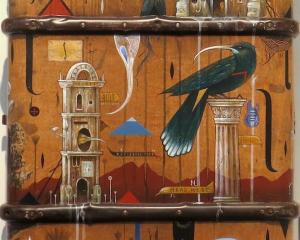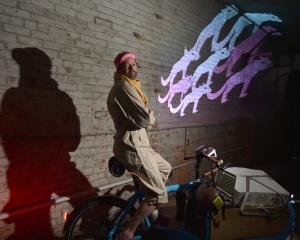Inspired by the night sky, by Bauhaus concepts, by deep space and many other things, Dunedin-based choreographer Daniel Belton has created Satellites for the Royal New Zealand Ballet's season of ''Allegro''. Charmian Smith reports.
As a child, Daniel Belton loved looking at the stars at night. With its clear skies unpolluted by stray light, southern New Zealand is one of the best places to do it, especially in the starlight reserve in the Mackenzie Country, he says.
It's one of many things that has fed into his current work for the Royal New Zealand Ballet, Satellites, which is touring the country as part of the company's ''Allegro: Five short ballets'' season.
Wherever he is, working in Europe, Asia, the US or New Zealand, the Dunedin-based dancer and choreographer is taking notice of what is around him, whether it's art or science, people or things.
''I'm researching all the time and it rubs off. It all feeds into the artistic process and sometimes some of these things might become a real focus at some point,'' he says.
One of those points is Satellites, commissioned by Ethan Steifel, artistic director of the RNZB.
Stargazing may be to do with analysis and technology, observatories, the Hubble telescope, electronic communications and satellites, but at its core is responding to nature, the cosmos, he says.
This work is a merger of shared experience and collaboration with other artists, some he has worked with before in his Good Company Arts projects, and some new.
Dutch composer Jan-Bas Bollen, with whom he has collaborated on more than 10 projects, has created the soundtrack for Satellites.
They met when Bollen was living in Dunedin in 2001 while his wife, Alison Isadora, was Mozart Fellow at the University of Otago.
''There was just this spark straight away. We listened to music and Dan stayed for hours, just talking and brainstorming about art,'' Bollen said.
He is back in New Zealand as the project comes to fruition.
''When we are together in a space and bouncing ideas, there's a real dialogue and it's electric,'' Belton said.
''It's also really important to reflect on what we are doing as we are going, so there's benefit in the long-distance collaboration and time delay because you get to reflect on everything all the time.''
Dunedin digital artist and longtime collaborator with Belton, Jac Grenfell, is producing motion graphics for the project.
A new collaboration is with kinetic sculptor Jim Murphy, from the US, who is living in Wellington.
''Ethan introduced me to Jim Murphy and said he thought we might find a spark and we did. We met in a cafe and we just spoke about Bauhaus and Oskar Schlemmer and Alexander Calder; all the influences came in.''
The kinetic sculptures are like big sails, the sort satellites might have for bouncing data and gathering light for power, he said.
Donnine Harrison, dancer, choreographer, collaborator and Belton's wife, designed the costumes, partly influenced by some of Schlemmer's geometric costumes for his 1922 Triadisches Ballett (Triadic Ballet).
Belton often uses objects to extend the body and in this work the dancers carry silver discs that relate to Murphy's kinetic sculptures.
For the first time he has an assistant choreographer, Verity Jacobsen, a former pupil and dancer in some of his projects.
''She's been invaluable. It's the first time I've worked like that and it's meant I can focus on the design and direction of the whole shape of the work. She knows the way I move and my language and technique closely. I could say to her 'let's go phrase A and connect that to phrase B then go to phrase E' and she would knit it together a bit like the way I edit,'' Belton said.
Although originally intending to work with six to 10 dancers, the usual number in his projects for practical purposes such as expense and touring, in Satellites he has been able to use 16 dancers.
Belton says he is known as a risk taker, although it's a calculated risk.
He likes pushing boundaries in his projects, whether they are live shows, films or videos.
However, he says he hasn't gone off on a tangent in this piece.
''It's definitely within the ballet idiom but it is a contemporary work. It's a lyrical work, very dancey, so it's not totally strange,'' he said.
''Ethan and the company want something that is really enjoyable to watch, entertaining, and so do the New Zealand public and that's what we are delivering. It's a dynamic work.''
Although an abstract piece, it has clear acoustic and visual frameworks and the whole theatre space is filled with live projections, kinetic sculptures above, dancers and layers of sound, Belton said.
Although electronic music can be sterile, Bollen says he has always tried to bring in an element that makes the sound come alive.
''The sound in itself must be organic, live a life of its own. I try to introduce human timing instead of a straight sequence of computer timing. That means a beat is never completely tight. There's always some fluctuation and, in order to do that, I often bring in a percussionist or instrumentalist or myself just to guarantee that human aspect,'' he said.
''Then there is the element of layering. The electronic music I find interesting is often multilayered. There is always a foreground layer and a background layer or several background layers that can be distinguished, separate from each other.''
He sees the music as the connection of all the concepts and elements in the performance, like a vessel that contains it all or a wave that carries them all.
Belton describes Bollen's music as a tapestry of sound, with many layers and full of movement, so it's a rich place to work with in terms of dance.
The inspiration goes both ways.
Belton talked about jewels, the sparkle of diamonds and gemstones, which Bollen tried to catch and include in his sound.
''Satellites really sparkles. Acoustically it's full of these spikes and references to radio space astronomy, and visually it's like that as well. In parts of the sonography, the dancers work with mirrors and refract light,'' Belton said.
''I was interested that the space in the theatre was like a big circuit board. Again, it's that nature and technology combination when you are talking about deep space and Hubble technology. I thought we could call it Satellites. A human dancer is a satellite; we are all orbiting each other all the time. Everything is moving all the time. In the universe movement is the basic datum, as Paul Klee said.
''It is an abstract work but within it there are solos and trios and duos. Every time I watch the piece in the studio, I see different little stories. It's like a river with an eddy and it comes back around and there's something you didn't notice. It's like a long conversation, like dialogues bouncing between the different stations of that circuit board which anchors everything,'' Belton says.
See it
''Allegro'' is at the Regent Theatre in Dunedin on August 23.











![... we all become all of these things [installation view] (2025), by Megan Brady.](https://www.odt.co.nz/sites/default/files/styles/odt_landscape_small_related_stories/public/story/2025/03/1_we_all_become_all_of_thes.jpg?itok=nicA_yAm)
